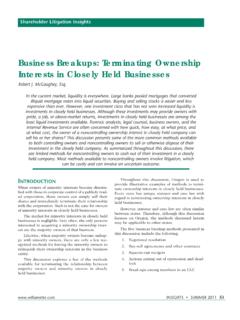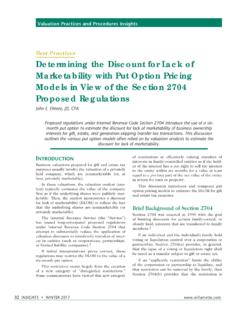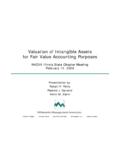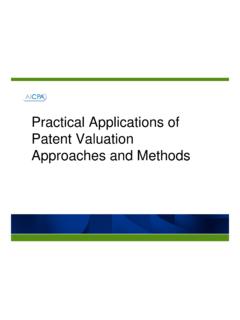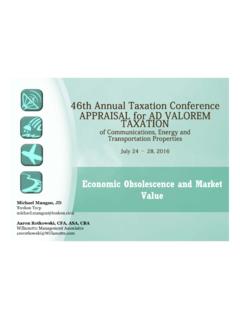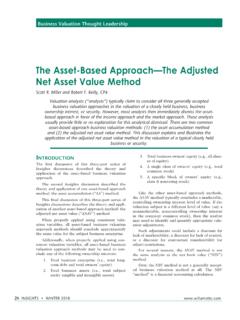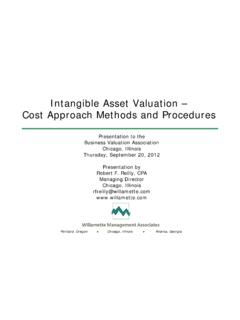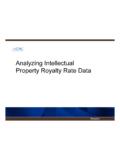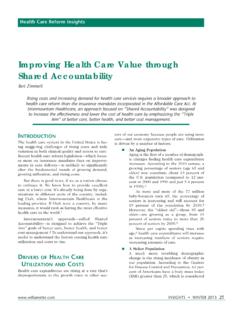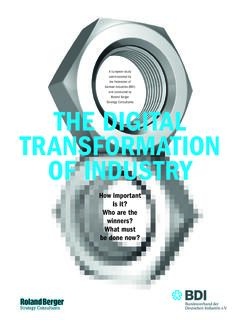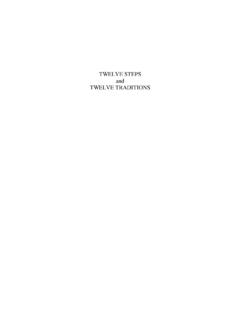Transcription of Methods for Valuing Customer Relationships: Use of the ...
1 70 INSIGHTS SPRING 2016 www .willamette .comMethods for Valuing Customer Relationships: Use of the Multi-Period Excess Earnings Method or the Distributor Method?Lisa H. Tran and Irina VrublevskayaForensic Analysis InsightsThe income approach is a common approach used in the valuation of Customer -related intangible assets. Within the income approach, the multi-period excess earnings method is a common method to value Customer relationships. In recent years, valuation analysts have used the distributor method, also an income-based approach, as an alternative method to Valuing the Customer relationship intangible asset.
2 This discussion describes the two valuation Methods and provides guidance on the appropriate use of each may devote significant human and finan-cial resources to develop, maintain, and upgrade their Customer relationships. More broadly, cus-tomer-related intangible assets consist of the infor-mation collected from repeat transactions, with or without underlying contracts. Companies can lease, sell, buy, or otherwise trade such information, generally organized as Customer lists or Customer databases. Although Customer lists are often sold, licensed, or rented, there are relatively few transactional reasons for analyzing Customer intangible assets.
3 Customer intangible assets are typically sold as part of a going-concern business enterprise. This is because it is unusual for the owner/operator to sell the Customer relationships outright and then continue to operate the business without the estab-lished Customer , there are relatively few fee simple interest sales of Customer relationship assets between a willing buyer and seller. The owner/operator either uses its Customer relationships or sells the business including the relationships to a new owner/operator.
4 As such, valuation analysts may be called on to value Customer relationships for financial accounting, taxation, or litigation purposes. The analyst may need to value Customer rela-tionships for the following purposes:1. Financial accounting, which may arise in acquisition accounting, impairment testing, and fresh start accounting2. Tax planning and compliance, which may include cancellation of debt income solven-cy analysis, transfer price analysis, proper-ty tax value of exempt or taxable intangible assets, and valuation of intangible assets to establish the tax basis of assets contributed in a formation or the gain/loss on assets distributed in a dissolution3.
5 Forensic and litigation reasons, such as lost profit or economic damages related to a breach of Customer or supplier contract or noncompetition agreement; family law dis-putes; shareholder disputes; condemnation or eminent domain actions; or income, gift, estate, or property tax disputesAll three generally accepted valuation approach-es (cost, market, and income) may be applicable in www .willamette .com INSIGHTS SPRING 2016 71the valuation of Customer -related intangible assets. Based on the type of Customer -related intangible asset and the purpose of the valuation analysis, some valuation approaches and Methods may be more applicable than income approach is a common approach used in the valuation of Customer -related intangible assets.
6 Within the income approach, the meth-ods typically used to value Customer relationships include the multi-period excess earnings method (MPEEM) and the distributor method (DM). While the MPEEM is a common method used to value cus-tomer relationships, the DM has been recognized in recent years as an alternative discussion summarizes the use of the MPEEM and the DM in the Customer relationship valuation and the strengths and weaknesses of each method. Considering the MPEEM and the DM, the analyst may select all appropriate Methods for valu-ing the Customer relationship asset based on the facts and circumstances of the subject asset and the availability of required elements oF Customer relatIonshIP sWhen determining if a Customer relationship asset exists, the analyst should consider several elements that create that intangible a Customer relationship asset to exist, it should have an informational component.
7 Or factual infor-mation about the Customer that is important and useful to the information may include such attributes as name, address, telephone number, email address, social security number, Customer account num-ber, credit rating, insurance information, or other third-party payer information. It may also include account information, date of first and last purchase, accounts receivable balance, trends, the amounts purchased (last year, greatest, etc.), Customer pay-ment record, and other account , the informational element may include information relating to the Customer s purchase preferences, frequency, seasonality, trends, pur-chase responses to sales, promotions, solicitations, and price changes, and purchase responses to new offerings.
8 It takes time and money to assemble, maintain, and use the Customer account informa-tion. The company maintains this information in order to manage its Customer relationships and motivate its customers to continue purchasing the goods or services offered by the company has the expectation of repeat patron-age from its customers based on the customers historical purchase activity, which creates value for Customer -related intangible assets. This expectation translates into the expectation of future revenue, income, and cash contracts formally codify the expecta-tion of future transactions from Customer relation-ships.
9 Even in the absence of contracts, companies will seek to build on past interactions with custom-ers in order to sell them products and services in the are two traits of repeat patronage that are important in Valuing Customer relationships. First, every Customer contact will not lead to an expecta-tion of repeat patronage. For example, the quality of interaction with a walk-in retail Customer is typi-cally not considered adequate enough to lead to reli-able expectations of recurring , even when adequate information is present, not all expected repeat patronage may be attributable to Customer -related intangible assets.
10 This is because some companies may operate in monopolistic or near-monopolistic industries, where repeat business can be directly attributable to a deficient availability of acceptable alternatives to the company s products or addition, recurring patronage may also be more appropriately attributable to the strength of the company s trade names or brands. However, typically, if the company continues to provide sat-isfactory products or services and use the Customer information effectively, it may expect reasonable continued intangible assets create value over a finite period of time.

